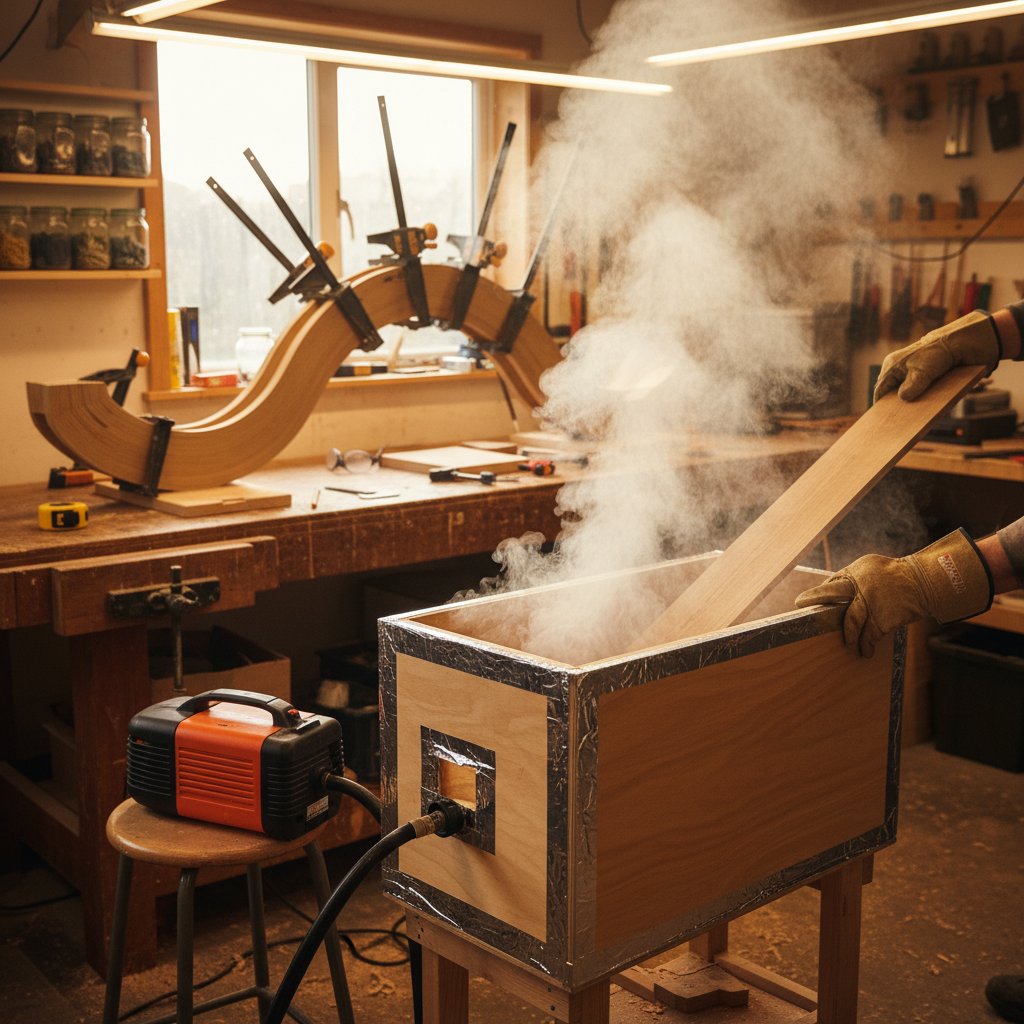Ever found yourself admiring furniture with those elegant, sweeping curves and thought, “How do they do that?” For a long time, I did too! Curved wood panels add a touch of sophistication and organic beauty that straight lines just can’t replicate. But the thought of creating them myself felt like a master craftsman’s secret, far beyond the reach of my home workshop. That is, until I discovered the magic of steam bending. And let me tell you, it’s not nearly as intimidating as it sounds!
My journey into steam bending started with a simple desire to build a unique side table. I wanted a curved apron, something that would flow gracefully. Research led me down the rabbit hole of laminated bending (which is fine, but can be wasteful and complex) and then, finally, to steam bending. The idea of using nothing but heat and moisture to make wood pliable enough to bend into a desired shape, then hold that shape once dry, was absolutely captivating. It felt like I was tapping into an ancient woodworking technique, and the results, once I got the hang of it, were incredibly rewarding.
If you’ve been dreaming of adding curves to your woodworking projects – be it a chair back, a cabinet door, or just a decorative panel – you’ve come to the right place. In this article, I’m going to share my hands-on experience, the lessons I’ve learned (often the hard way!), and a practical guide to setting up your own home steam bending operation. We’ll talk through everything from building a simple steam box to selecting the right wood and bending it into submission. Get ready to unlock a whole new dimension in your woodworking!
Why Bother with Steam Bending? The Magic Behind the Curve
Before we dive into the nitty-gritty, let’s chat about why steam bending is such a fantastic technique, especially for panels. When you laminate wood for curves, you’re gluing together thin strips. While effective, it often involves a lot of glue, and the grain pattern is often cut across, which can sometimes weaken the piece and obscure the natural beauty of the wood. With steam bending, you’re taking a single, solid piece of wood and simply changing its form.
- Preserves Grain Strength: The biggest advantage is that the wood’s grain runs continuously through the curve, maintaining its natural strength. This results in incredibly robust and resilient curved pieces.
- Natural Beauty: The uninterrupted grain flow looks stuing. It highlights the natural patterns and colors of the wood, creating a much more organic and fluid aesthetic.
- Less Waste: Compared to cutting curves from a thick plank (which generates a lot of sawdust and offcuts), steam bending can be more efficient with material.
- Unique Aesthetics: The look and feel of a steam-bent piece are distinct. It often has a softer, more inviting appearance than a sharply cut or laminated curve.
The science behind it is pretty cool too. Wood is made up of cellulose fibers held together by a substance called lignin. When exposed to hot steam, the lignin softens, allowing the wood fibers to slide past each other without breaking. Once the wood cools and dries in its new shape, the lignin re-hardens, effectively “locking in” the curve. It’s like magic, but it’s pure science!
Gather Your Gear: What You’ll Need for Your Home Steam Bending Setup
You don’t need a factory to start steam bending. Most of what you need can be found in a typical home workshop or easily sourced. Here’s a rundown of my essential tools and materials:
1. The Steam Box: Your Wood’s Sauna
This is the heart of your operation. It needs to be relatively airtight to hold the steam and can be surprisingly simple to make.
-
DIY Option (My Preferred): I made mine from some scrap 3/4-inch plywood. The key is to make it long enough for your longest plaed pieces and deep/wide enough for your thickest. Mine is about 4 feet long, 6 inches wide, and 8 inches deep. I screwed the sides together, sealed the seams with silicone caulk, and added a hinged lid with a latch. Important features:
- Steam Inlet: A hole at one end (I used a 1-inch spade bit) to coect to your steam source.
- Drain Hole: A small hole at the bottom of the opposite end to allow condensation to escape. This prevents the wood from sitting in water.
- Wood Supports: A few dowels or pieces of scrap wood ruing across the inside to keep your wood pieces elevated, allowing steam to circulate all around them.
- Insulation: While not strictly necessary for short runs, insulating your box with rigid foam or old blankets will make it more efficient and maintain a higher temperature.
- Alternative: You can buy commercial steam boxes, but for home use, a DIY version is more economical and totally effective.
2. The Steam Source: Generating the Heat
You need a reliable way to generate a steady stream of hot steam.
- Wallpaper Stripper: This is my go-to. They are relatively inexpensive, designed to produce continuous steam, and come with a hose that’s perfect for coecting to your steam box.
- Pressure Cooker/Kettle: Some people adapt a pressure cooker or a large kettle with a hose, but ensure it’s safe and can handle continuous operation. Be very careful with homemade setups involving pressure.
3. The Wood: Not All Trees Are Equal
This is crucial! Some woods bend beautifully, others resist and crack. My best results have been with:
- White Oak, Red Oak, Ash, Elm: These are fantastic and very forgiving.
- Walnut, Cherry, Maple: Can also work well, but might be a bit more challenging or require longer steaming times.
- Avoid: Woods with interlocking grain (like some tropical hardwoods), very resinous woods (pine, spruce), or woods that are naturally brittle.
- Grain Orientation: Look for clear, straight grain. Avoid knots or highly figured sections as these are prime candidates for cracking.
4. Forms and Molds: Shaping Your Vision
You’ll need something to bend your hot wood around. This can be as simple or complex as your project demands.
- Material: Plywood, MDF, or even solid wood blocks.
- Design: Your form needs to be robust enough to withstand clamping pressure. Cut it to the desired curve. For panels, I often make a male and female mold (a positive and negative shape) to ensure uniform pressure.
- Clamping: You’ll need plenty of clamps! Bar clamps, pipe clamps, F-clamps – whatever you have on hand. Consider adding quick-release straps for faster clamping.
5. Safety Gear & Other Tools
- Heat-Resistant Gloves: Essential for handling hot, wet wood.
- Eye Protection: Always a good idea in the workshop.
- Metal Straps/Banding: For tighter curves or less cooperative wood, a metal strap on the outside of the curve helps prevent the wood from “blowing out” on the tension side. It’s a game-changer!
- Measuring Tools: Tape measure, pencil.
- Workbench: A sturdy place to work quickly.
Prepping Your Wood: Setting the Stage for Success
Once you have your gear, the preparation of your wood is paramount.
- Selection: Again, choose clear, straight-grained sections. I often find that wood with a higher moisture content (even air-dried rather than kiln-dried) tends to bend more easily. If you have access to green wood, even better!
- Sizing: Cut your wood to rough dimensions, leaving some extra length and width. This allows for trimming after bending and accounts for any slight spring-back or imperfections. For instance, if I need a panel 12 inches long, I might cut it to 14 inches.
- Thickness: Thicker wood requires longer steaming times and more clamping pressure. Start with thier stock (e.g., 1/4 inch to 1/2 inch) until you get the hang of it.
The Steaming Process: Heat, Time, and Patience
This is where the magic really begins!
- Set Up: Coect your steam source to the inlet of your steam box. Place your wood pieces on the internal supports, ensuring they aren’t touching the bottom or sides of the box excessively.
- Seal it Up: Close the lid of your steam box tightly. Make sure the drain hole is clear.
- Fire it Up: Turn on your steam source. You should see steam start to escape from the drain hole and any small gaps. This indicates good circulation.
- Steaming Time: The general rule of thumb is 1 hour of steaming for every inch of wood thickness. So, a 1/2-inch thick piece would need about 30 minutes, a 1-inch piece an hour. However, I’ve found that some woods benefit from a bit longer, especially if they are kiln-dried. Err on the side of slightly longer steaming rather than too short. The wood needs to be thoroughly heated through.
- Monitor: Keep an eye on your steam source to ensure it doesn’t run out of water.
Safety Warning: Steam is incredibly hot! Always wear heat-resistant gloves and eye protection. Never put your face directly over the steam box opening.
The Bending Moment: Quick, Careful, and Clamped
This is the most critical part, and it happens fast. You have a very limited window (literally seconds to a minute or two) before the wood starts to cool and stiffen.
- Prepare Your Form: Have your bending form and all your clamps laid out and ready. If using a metal strap, have it positioned and ready to go around the wood.
- Retrieve Quickly: With your heat-resistant gloves, quickly but carefully remove the steamed wood from the box. It will be hot, wet, and incredibly pliable.
- Position on Form: Immediately place the hot wood onto your bending form. If using a metal strap, position it on the outside of the curve (the tension side) now.
- Clamp Strategically: Start clamping from the middle of the bend and work your way outwards. Apply firm, steady pressure. Don’t rush or force it excessively, but don’t hesitate either. You want to coax the wood into the curve, not break it.
- Even Pressure: Ensure the wood is fully in contact with the form along its entire length. Use as many clamps as needed to achieve this. If you have a male/female mold, clamp them together around the wood.
If you hear sharp cracking sounds, you might be forcing it too much, the wood wasn’t steamed long enough, or it’s a difficult piece. Don’t be discouraged if your first few attempts don’t come out perfect. It’s a learned skill!
Drying and Finishing: The Final Stretch
Once bent, the wood needs to cool and dry thoroughly in its clamped position. This is where the lignin re-hardens and locks in the new shape.
- Drying Time: This is not a quick process. Depending on the wood species, thickness, and humidity, it can take anywhere from a few days to several weeks. I usually leave my pieces clamped for at least 5-7 days for thier pieces and often 2-3 weeks for thicker ones. Patience here is key!
- Spring-Back: Even after thorough drying, wood will often “spring back” slightly from its original curve once unclamped. This is normal. To account for this, I sometimes make my forms slightly tighter than the final desired curve. You’ll learn the spring-back rate for different woods and thicknesses as you gain experience.
- Unclamping and Inspecting: Once fully dry, carefully unclamp your piece. Inspect it for any cracks or imperfections. You’ll likely be amazed at the beautiful, permanent curve you’ve created!
- Finishing: Now you can trim the ends, sand the surface, and incorporate your newly curved panel into your project.
Troubleshooting & Tips from My Workbench
- Cracking/Splitting: This is the most common issue. Usually, it means the wood wasn’t steamed long enough (not pliable enough), you bent it too quickly, or the wood itself wasn’t suitable (too dry, knotty, or the wrong species). Ensure a metal strap is used for tight bends.
- Not Bending Enough/Resisting: Again, likely insufficient steaming time. Or, perhaps your form isn’t robust enough, or you need more clamping pressure.
- Steam Box Leaks: Small leaks are fine, but large ones mean you’re losing heat and steam. Re-seal with silicone caulk or weatherstripping.
- Start Small: Don’t try to bend a massive, thick panel on your first go. Start with smaller, thier pieces of easily bendable wood (like oak) to build your confidence and refine your technique. Scrap wood is your best friend here!
- Work Quickly: The window for bending is short. Have everything prepared and staged before you open that steam box.
Conclusion
My first successful steam-bent piece felt like a major accomplishment. It opened up a world of design possibilities I hadn’t considered before, transforming my simple woodworking projects into something far more artistic and elegant. The satisfaction of seeing a rigid piece of wood transform into a graceful curve, held purely by the strength of its own fibers, is truly unique.
Yes, there’s a learning curve (pun intended!), and you’ll probably have a few pieces crack or spring back more than you’d like. But that’s part of the journey! Each attempt teaches you something new about the wood, the steam, and your own technique. So, if you’ve been wanting to add some organic flair to your home projects, I wholeheartedly encourage you to give steam bending a try. Build that simple steam box, pick up some forgiving wood, and prepare to be amazed at what you can create. Your home workshop is about to get a whole lot curvier!



